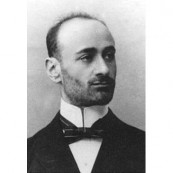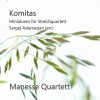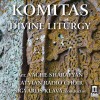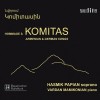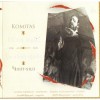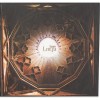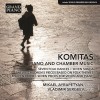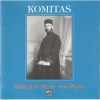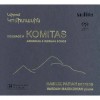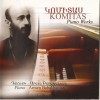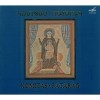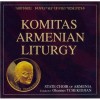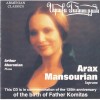Composers
Soghomon Soghomonian, commonly known as Komitas (Armenian: Կոմիտաս; Gomidas in Western Armenian) (26 September or 8 October[a] 1869 – October 22, 1935), was an Armenian priest, composer, choir leader, singer, music ethnologist, music pedagogue and musicologist. Many regard him as the founder of modern Armenian classical music.
Komitas experienced a mental breakdown after witnessing the horrors of 1915 Armenian Genocide and is considered a martyr of the genocide.
Soghomon Soghomonyan was born into a family whose members were deeply involved in music and were monolingual in Turkish. His mother died when he was one, and his father died ten years later. His grandmother looked after him until 1881, when a prelate of the local Armenian diocese went to Echmiadzin to be consecrated a bishop. The catholicos Gevork IV ordered him to bring one orphaned child to be educated at the Echmiadzin Seminary. Soghomon was chosen among 20 candidates and admitted into the seminary (where he impressed the catholicos with his singing talent) and graduated in 1893, after which he became a monk. According to church tradition, newly ordained priests are given new names, and Soghomon was renamed Komitas (named after the seventh-century Armenian catholicos who was also a hymn writer). Two years later, he was elevated in rank to archimandrite and obtained the title Vardapet (or Vartabed), meaning a "doctor of the church" or "divine scholar".
He established and conducted the monastery choir until 1896, when he went to Berlin, enrolled at Kaiser Friedrich Wilhelm University and studied music at the private conservatory of Prof. Richard Schmidt. In 1899, he acquired the title Doctor of Musicology and returned to Echmiadzin, where he took over conducting a polyphonic male choir. He traveled extensively around the country, listening to and recording details about Armenian folk songs and dances performed in various villages. This way, he collected and published some 3,000 songs, many of them adapted to choir singing.
His major work is Badarak (Divine Liturgy), still used today as one of the two most popular musical settings of the Armenian Church liturgy or mass, which he started composing in 1892 but never completely finished due to the upcoming World War I. For the basis of the work, he took chants sung by the eldest priests and upgraded it with typical ("cleaned" of foreign influences) Armenian music elements from his collected material. Today the best-known version of Badarak is his favourite for a four-voiced male choir. It must be understood that the Komitas Badarak was not an original composition per se, but rather an arrangement of the pre-existing melodies in use by Armenian priests for the singing of the mass. The words certainly are not original but are the text of the Armenian mass, which has been used for centuries. Armenian Church music was traditionally monophonic, but Makar Yekmalian, Komitas, and several other musician/composers in the 19th and 20th centuries arranged polyphonic versions of the pre-existing melodies. Some composers (but not Komitas or Yekmalian) created completely original musical settings of the liturgy as well.
He was the first non-European to be admitted into the International Music Society, of which he was a co-founder. He gave many lectures and performances throughout Europe, Turkey and Egypt, thus presenting till then very little known Armenian music.
From 1910, he lived and worked in Istanbul. There, he established a 300-member choir, Gusan.
Recently Added
| Country: | Armenia |
| Period: | XIX century |
Biography
Soghomon Soghomonian, commonly known as Komitas (Armenian: Կոմիտաս; Gomidas in Western Armenian) (26 September or 8 October[a] 1869 – October 22, 1935), was an Armenian priest, composer, choir leader, singer, music ethnologist, music pedagogue and musicologist. Many regard him as the founder of modern Armenian classical music.
Komitas experienced a mental breakdown after witnessing the horrors of 1915 Armenian Genocide and is considered a martyr of the genocide.
Soghomon Soghomonyan was born into a family whose members were deeply involved in music and were monolingual in Turkish. His mother died when he was one, and his father died ten years later. His grandmother looked after him until 1881, when a prelate of the local Armenian diocese went to Echmiadzin to be consecrated a bishop. The catholicos Gevork IV ordered him to bring one orphaned child to be educated at the Echmiadzin Seminary. Soghomon was chosen among 20 candidates and admitted into the seminary (where he impressed the catholicos with his singing talent) and graduated in 1893, after which he became a monk. According to church tradition, newly ordained priests are given new names, and Soghomon was renamed Komitas (named after the seventh-century Armenian catholicos who was also a hymn writer). Two years later, he was elevated in rank to archimandrite and obtained the title Vardapet (or Vartabed), meaning a "doctor of the church" or "divine scholar".
He established and conducted the monastery choir until 1896, when he went to Berlin, enrolled at Kaiser Friedrich Wilhelm University and studied music at the private conservatory of Prof. Richard Schmidt. In 1899, he acquired the title Doctor of Musicology and returned to Echmiadzin, where he took over conducting a polyphonic male choir. He traveled extensively around the country, listening to and recording details about Armenian folk songs and dances performed in various villages. This way, he collected and published some 3,000 songs, many of them adapted to choir singing.
His major work is Badarak (Divine Liturgy), still used today as one of the two most popular musical settings of the Armenian Church liturgy or mass, which he started composing in 1892 but never completely finished due to the upcoming World War I. For the basis of the work, he took chants sung by the eldest priests and upgraded it with typical ("cleaned" of foreign influences) Armenian music elements from his collected material. Today the best-known version of Badarak is his favourite for a four-voiced male choir. It must be understood that the Komitas Badarak was not an original composition per se, but rather an arrangement of the pre-existing melodies in use by Armenian priests for the singing of the mass. The words certainly are not original but are the text of the Armenian mass, which has been used for centuries. Armenian Church music was traditionally monophonic, but Makar Yekmalian, Komitas, and several other musician/composers in the 19th and 20th centuries arranged polyphonic versions of the pre-existing melodies. Some composers (but not Komitas or Yekmalian) created completely original musical settings of the liturgy as well.
He was the first non-European to be admitted into the International Music Society, of which he was a co-founder. He gave many lectures and performances throughout Europe, Turkey and Egypt, thus presenting till then very little known Armenian music.
From 1910, he lived and worked in Istanbul. There, he established a 300-member choir, Gusan.
